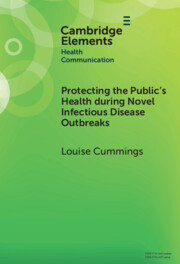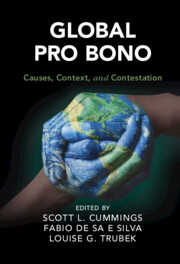212 results

Protecting the Public's Health during Novel Infectious Disease Outbreaks
- Coming soon
-
- Expected online publication date:
- October 2024
- Print publication:
- 31 October 2024
-
- Element
- Export citation
Community Clozapine Initiation Practice
-
- Journal:
- BJPsych Open / Volume 10 / Issue S1 / June 2024
- Published online by Cambridge University Press:
- 01 August 2024, p. S270
-
- Article
-
- You have access
- Open access
- Export citation
18 - The Role of Context in Clinical Linguistics
- from Part IV - Applications of Context Studies
-
-
- Book:
- The Cambridge Handbook of Language in Context
- Published online:
- 30 November 2023
- Print publication:
- 14 December 2023, pp 393-416
-
- Chapter
- Export citation
Index
-
- Book:
- Global Pro Bono
- Published online:
- 06 May 2022
- Print publication:
- 07 April 2022, pp 705-729
-
- Chapter
- Export citation
Contributors
-
- Book:
- Global Pro Bono
- Published online:
- 06 May 2022
- Print publication:
- 07 April 2022, pp vii-xii
-
- Chapter
- Export citation
Chapter One - What Is Global about Pro Bono and What Is Global Pro Bono About?
-
-
- Book:
- Global Pro Bono
- Published online:
- 06 May 2022
- Print publication:
- 07 April 2022, pp 1-74
-
- Chapter
- Export citation
Part Five - Asia
-
- Book:
- Global Pro Bono
- Published online:
- 06 May 2022
- Print publication:
- 07 April 2022, pp 601-704
-
- Chapter
- Export citation
Part One - The Americas
-
- Book:
- Global Pro Bono
- Published online:
- 06 May 2022
- Print publication:
- 07 April 2022, pp 75-212
-
- Chapter
- Export citation
Part Three - OCEANIA
-
- Book:
- Global Pro Bono
- Published online:
- 06 May 2022
- Print publication:
- 07 April 2022, pp 475-532
-
- Chapter
- Export citation
Contents
-
- Book:
- Global Pro Bono
- Published online:
- 06 May 2022
- Print publication:
- 07 April 2022, pp v-vi
-
- Chapter
- Export citation
Part Four - Africa
-
- Book:
- Global Pro Bono
- Published online:
- 06 May 2022
- Print publication:
- 07 April 2022, pp 533-600
-
- Chapter
- Export citation

Global Pro Bono
- Causes, Context, and Contestation
-
- Published online:
- 06 May 2022
- Print publication:
- 07 April 2022
Copyright page
-
- Book:
- Global Pro Bono
- Published online:
- 06 May 2022
- Print publication:
- 07 April 2022, pp iv-iv
-
- Chapter
- Export citation
Part Two - Europe
-
- Book:
- Global Pro Bono
- Published online:
- 06 May 2022
- Print publication:
- 07 April 2022, pp 213-474
-
- Chapter
- Export citation
Associations between the composition of functional tooth units and nutrient intake in older men: the Concord Health and Ageing in Men Project
-
- Journal:
- Public Health Nutrition / Volume 24 / Issue 18 / December 2021
- Published online by Cambridge University Press:
- 20 August 2021, pp. 6335-6345
-
- Article
-
- You have access
- HTML
- Export citation
Associations between nutrient intakes and dietary patterns with different sarcopenia definitions in older Australian men: the concord health and ageing in men project - ERRATUM
-
- Journal:
- Public Health Nutrition / Volume 24 / Issue 2 / February 2021
- Published online by Cambridge University Press:
- 27 November 2020, pp. 378-383
-
- Article
-
- You have access
- HTML
- Export citation
Associations between nutrient intakes and dietary patterns with different sarcopenia definitions in older Australian men: the concord health and ageing in men project
-
- Journal:
- Public Health Nutrition / Volume 24 / Issue 14 / October 2021
- Published online by Cambridge University Press:
- 07 October 2020, pp. 4490-4505
-
- Article
-
- You have access
- HTML
- Export citation
Contents
-
- Book:
- Language in Dementia
- Published online:
- 18 September 2020
- Print publication:
- 01 October 2020, pp v-viii
-
- Chapter
- Export citation
Copyright page
-
- Book:
- Language in Dementia
- Published online:
- 18 September 2020
- Print publication:
- 01 October 2020, pp iv-iv
-
- Chapter
- Export citation
Answers to Exercises
-
- Book:
- Language in Dementia
- Published online:
- 18 September 2020
- Print publication:
- 01 October 2020, pp 221-239
-
- Chapter
- Export citation

